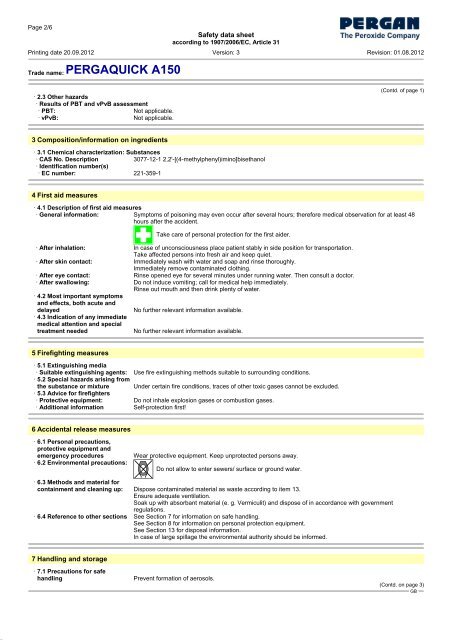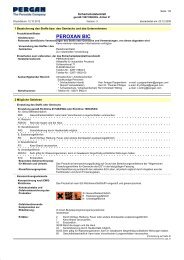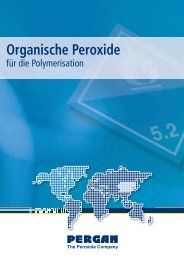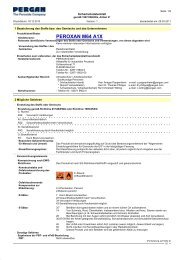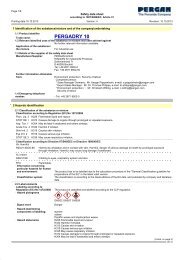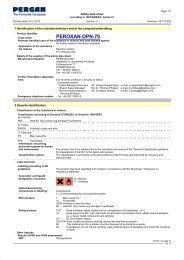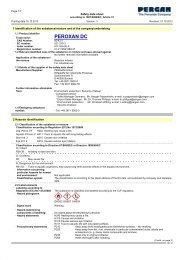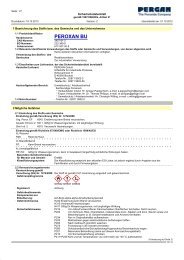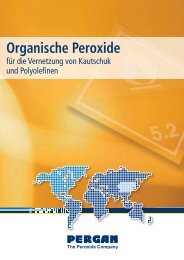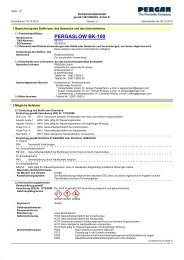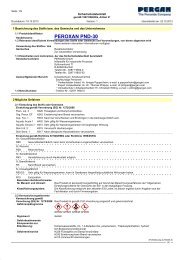PERGAQUICK A150 - Pergan GmbH
PERGAQUICK A150 - Pergan GmbH
PERGAQUICK A150 - Pergan GmbH
Create successful ePaper yourself
Turn your PDF publications into a flip-book with our unique Google optimized e-Paper software.
35.0.28<br />
Page 2/6<br />
Printing date 20.09.2012<br />
Safety data sheet<br />
according to 1907/2006/EC, Article 31<br />
Version: 3<br />
Revision: 01.08.2012<br />
Trade name: <strong>PERGAQUICK</strong> <strong>A150</strong><br />
· 2.3 Other hazards<br />
· Results of PBT and vPvB assessment<br />
· PBT: Not applicable.<br />
· vPvB: Not applicable.<br />
3 Composition/information on ingredients<br />
· 3.1 Chemical characterization: Substances<br />
· CAS No. Description 3077-12-1 2,2'-[(4-methylphenyl)imino]bisethanol<br />
· Identification number(s)<br />
· EC number: 221-359-1<br />
4 First aid measures<br />
(Contd. of page 1)<br />
· 4.1 Description of first aid measures<br />
· General information: Symptoms of poisoning may even occur after several hours; therefore medical observation for at least 48<br />
hours after the accident.<br />
?Z<br />
Take care of personal protection for the first aider.<br />
· After inhalation: In case of unconsciousness place patient stably in side position for transportation.<br />
Take affected persons into fresh air and keep quiet.<br />
· After skin contact: Immediately wash with water and soap and rinse thoroughly.<br />
Immediately remove contaminated clothing.<br />
· After eye contact: Rinse opened eye for several minutes under running water. Then consult a doctor.<br />
· After swallowing: Do not induce vomiting; call for medical help immediately.<br />
Rinse out mouth and then drink plenty of water.<br />
· 4.2 Most important symptoms<br />
and effects, both acute and<br />
delayed No further relevant information available.<br />
· 4.3 Indication of any immediate<br />
medical attention and special<br />
treatment needed No further relevant information available.<br />
5 Firefighting measures<br />
· 5.1 Extinguishing media<br />
· Suitable extinguishing agents: Use fire extinguishing methods suitable to surrounding conditions.<br />
· 5.2 Special hazards arising from<br />
the substance or mixture Under certain fire conditions, traces of other toxic gases cannot be excluded.<br />
· 5.3 Advice for firefighters<br />
· Protective equipment: Do not inhale explosion gases or combustion gases.<br />
· Additional information Self-protection first!<br />
6 Accidental release measures<br />
· 6.1 Personal precautions,<br />
protective equipment and<br />
emergency procedures Wear protective equipment. Keep unprotected persons away.<br />
· 6.2 Environmental precautions:<br />
Do not allow to enter sewers/ surface or ground water.<br />
?K@JL<br />
· 6.3 Methods and material for<br />
containment and cleaning up: Dispose contaminated material as waste according to item 13.<br />
Ensure adequate ventilation.<br />
Soak up with absorbant material (e. g. Vermiculit) and dispose of in accordance with government<br />
regulations.<br />
· 6.4 Reference to other sections See Section 7 for information on safe handling.<br />
See Section 8 for information on personal protection equipment.<br />
See Section 13 for disposal information.<br />
In case of large spillage the environmental authority should be informed.<br />
7 Handling and storage<br />
· 7.1 Precautions for safe<br />
handling Prevent formation of aerosols.<br />
(Contd. on page 3)<br />
GB


